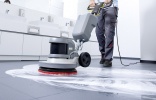Home › magazine › latest news › Key floor polishing trends
Key floor polishing trends
20th of June 2025Following the publication of the Interclean Top Trends for 2025 report, what are the key trends in floor polishing today? Ann Laffeaty poses the question.
A greater demand for ergonomic cleaning equipment designed to reduce the physical strain on the part of the cleaner is being predicted for this year. According to the Interclean Top 10 Trends for 2025 report - compiled in conjunction with ECJ - we will also be experiencing higher demand for non-toxic, eco-friendly cleaning solutions. And these are likely to use less energy while also achieving a higher performance.
The Interclean Top Trends report claims the cleaning and hygiene industry is undergoing a transformation which will provide a whole host of new opportunities. And this means key players will need to embrace the changes and adapt their equipment and working practices. How will this apply to floor polishing?
Ergonomics and user-comfort are becoming increasingly important to customers according to Kärcher’s floor care product management director Christian Mrowka. “Professionals often spend hours at a time operating floor polishing machines,” he said. “Minimising the strain on the part of the operator can result in reduced fatigue, fewer injuries and improved productivity. And the use of efficient machinery along with the correct choice of accessories and detergents allows customers to save time and reduce the physical impact.”
A move towards the use of non-toxic, user-friendly cleaning solutions is another significant trend the company has observed, adds Mrowka. “There is a growing awareness of the potential health and environmental impact of cleaning systems. Customers are increasingly seeking solutions that are not only effective but are also safe for users and the environment.”
Kärcher is expanding its portfolio of sustainable detergents with its new Natural line. This contains renewable raw materials and is said to be easier for users to handle while also saving on costs associated with shipping and storage.
New stripping agents, pads, floor machines and floor finishes are frequently being launched to improve productivity, Mrowka says. “These are also being developed to enhance performance, ergonomics and comfort. Customers will ensure great results by selecting the correct polishing method including the right machines, accessories and chemicals.”
Large, heavy items of machinery do not necessarily provide the best possible cleaning outcomes, he said. “Good results can be achieved using light and ergonomic machines combined with accessories and chemicals designed to deliver results in less time and with more comfort.”
Kärcher has experienced a marked increase in demand for products and systems that offer environmental benefits. “Customers are seeking ways of reducing their environmental footprint, conserving resources and promoting a healthier workplace,” Mrowka said. “And this plays a significant role in floor polishing.”
The standard methods of stripping resilient flooring such as PVC, laminate and LVT often involve the use of toxic chemicals, he adds. “The process of adding another coat of polish then has to be repeated several times per year on heavy-traffic areas due to wear,” he said. “However there are polishing methods, such as daily cleaning with diamond pads, that keep resilient floorings in a good condition and avoid the necessity of stripping and recoating.”
Maintaining a floor is more sustainable than installing all-new flooring, he says. “Resurfacing resilient floors considerably reduces cost, energy consumption and carbon footprint compared with a new installation,” he said.
Ergonomics, usability and sustainability have been the main cleaning industry trends in recent years according to Filmop’s Italy area manager Jimmy Vardanega. “Ergonomics is always a major focus, both in floor polishing and in cleaning in general,” he said. “The most successful companies are those that employ ergonomic equipment with the aim of reducing work-related diseases and illnesses as far as possible. This has the knock-on effect of minimising costs, which in turn makes them sustainable.”
He recognises a switch to user-friendly cleaning solutions is becoming another key trend. “These help to facilitate training and greatly reduce the chance of making mistakes,” he said. “Equipment that is more complex and less intuitive to use can have a negative impact on productivity.”
Sustainability also has a heavy influence on customer choice today, he says. “The demand for environmentally-sustainable solutions touches all areas of professional cleaning which is increasingly focused on environmental protection,” he said.
Less physical strain
Filmop’s Unilav Side Grip wax spreader is claimed to ease the task for the operator because it eliminates the need for lifting heavy buckets or continually raising and lowering the tool to dip it into the wax and then place it back on the ground. Features include a side dispensing knob that allows the operator to adjust the wax release, plus a mop holder with hooks said to ensure maximum adhesion to the mop.
Cleanology has also seen a growing demand for equipment that reduces physical strain on the operator says marketing director Kate Lovell. “Floor polishing machines are increasingly being designed with improved manoeuvrability and are incorporating features such as adjustable handles and lightweight materials. Meanwhile, the integration of automation in floor is allowing for hands-free operation of polishing equipment. And advanced sensors and AI-driven systems reduce the need for manual intervention.”
She says there has also been a notable shift towards the use of non-toxic, user-friendly solutions. “These prioritise the user’s health and safety while also being less harmful to the environment,” she said.
Many businesses are transitioning towards products and systems that offer sustainability benefits, according to Lovell. “This has contributed to a significant shift in the cleaning industry as a whole towards safer, more environmentally-conscious products and systems,” she said.
Cleanology uses lightweight floor polishing machinery designed to reduce the strain on the operator and provide access to hard-to-reach areas. The fact that the equipment is battery powered also removes the need for hazardous cables.
Like other commentators, Bona has also noted a demand for more ergonomic floor polishing equipment according to brand marketing manager Patrik Jacobsson. “This applies not only to the equipment itself - we have also witnessed facilities seeking new systems that reduce labour along with the costs related to floor polishing,” he said. “In fact the newer, more innovative floor treatments can eliminate the need to polish altogether.”
The demand for less toxic, user-friendly cleaning solutions has been growing globally, he says. And there has been a general trend towards floor polishing products and systems that offer sustainability benefits.
“Some European associations are establishing new objectives to institute practices that are more sustainable across the board,” he said. “For example one in the Netherlands, which gathers data from most cleaning companies in the country, recently agreed on a target to halt the polishing and stripping of linoleum floors by January 2027.”
No chemicals
He says the recommended sustainable alternative floor maintenance system is based on the use of permanent PU coatings. “The envisioned transition is regarded as a more sustainable floor maintenance method and includes sustainability benefits over a 10-year period,” said Jacobsson.
He claims these benefits include water savings of around 30 per cent; energy savings of 54 per cent; a 41 per cent reduction in CO2 and the removal of the need for chemical strippers.
“In addition, cleaning companies and specialised floor maintenance companies can reduce the amount of waste water associated with the stripping process which ends up in sewage systems,” he said.
The company’s Bona Resilient solution is a system of PU coatings and sanding machines that remove old polish via a chemical-free stripping agent. The PU coating applied afterwards boasts lasting protection and removes the need for a yearly polish and strip. The surface can then be sanded down and recoated every five years or so.
So what are the key floor polishing trends for 2025? Cleanology’s Kate Lovell has remarked a particular increase in demand for chemical-free cleaning. “This is safer both for the cleaner and for anyone else using the space,” she said.
Bona’s Patrik Jacobsson claims the use of permanent coatings is increasingly replacing the more established floor maintenance routines based on polish and stripping cycles. “Cleaning companies are becoming increasingly concerned about factors such as labour shortages, cost and the need for sustainability,” he said. “And floor owners are seeking better processes and are gravitating toward refinishing hardwood floors rather than replacing them in a bid to save money and reduce their environmental impact.”










